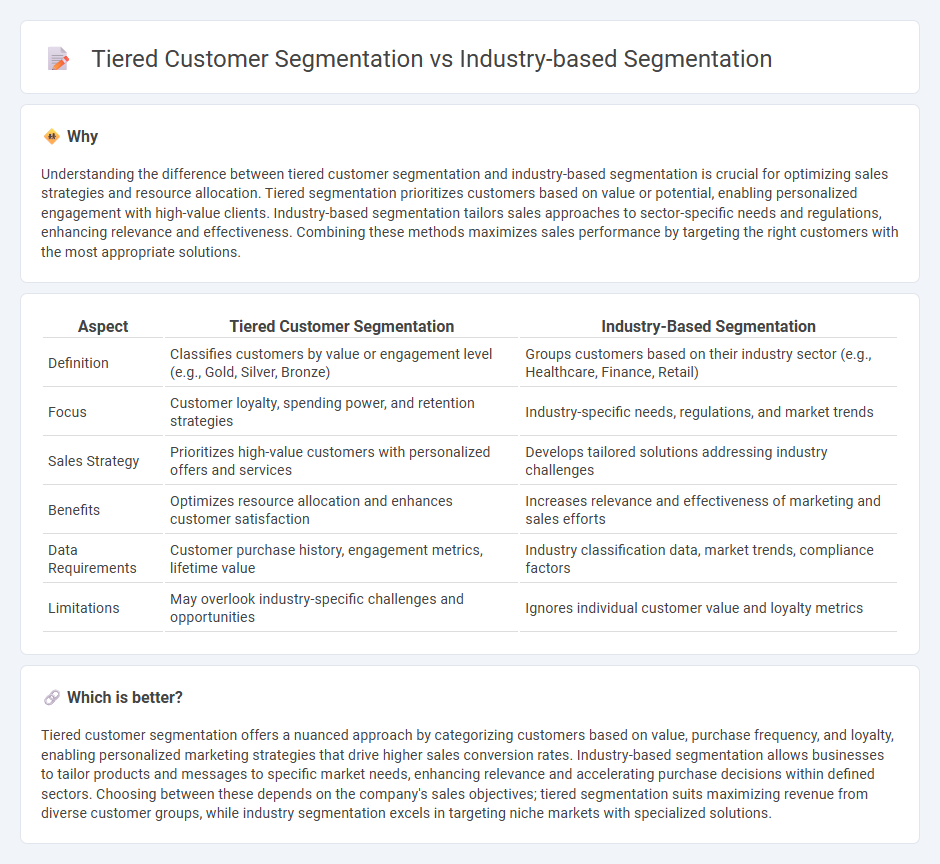
Tiered customer segmentation organizes clients based on purchasing behavior, revenue potential, or engagement levels, allowing businesses to tailor strategies and allocate resources efficiently. Industry-based segmentation categorizes customers by their specific sectors, enabling targeted solutions that address unique industry challenges and compliance requirements. Explore these approaches to optimize your sales strategy and maximize customer value.
Why it is important
Understanding the difference between tiered customer segmentation and industry-based segmentation is crucial for optimizing sales strategies and resource allocation. Tiered segmentation prioritizes customers based on value or potential, enabling personalized engagement with high-value clients. Industry-based segmentation tailors sales approaches to sector-specific needs and regulations, enhancing relevance and effectiveness. Combining these methods maximizes sales performance by targeting the right customers with the most appropriate solutions.
Comparison Table
| Aspect | Tiered Customer Segmentation | Industry-Based Segmentation |
|---|---|---|
| Definition | Classifies customers by value or engagement level (e.g., Gold, Silver, Bronze) | Groups customers based on their industry sector (e.g., Healthcare, Finance, Retail) |
| Focus | Customer loyalty, spending power, and retention strategies | Industry-specific needs, regulations, and market trends |
| Sales Strategy | Prioritizes high-value customers with personalized offers and services | Develops tailored solutions addressing industry challenges |
| Benefits | Optimizes resource allocation and enhances customer satisfaction | Increases relevance and effectiveness of marketing and sales efforts |
| Data Requirements | Customer purchase history, engagement metrics, lifetime value | Industry classification data, market trends, compliance factors |
| Limitations | May overlook industry-specific challenges and opportunities | Ignores individual customer value and loyalty metrics |
Which is better?
Tiered customer segmentation offers a nuanced approach by categorizing customers based on value, purchase frequency, and loyalty, enabling personalized marketing strategies that drive higher sales conversion rates. Industry-based segmentation allows businesses to tailor products and messages to specific market needs, enhancing relevance and accelerating purchase decisions within defined sectors. Choosing between these depends on the company's sales objectives; tiered segmentation suits maximizing revenue from diverse customer groups, while industry segmentation excels in targeting niche markets with specialized solutions.
Connection
Tiered customer segmentation classifies buyers based on value or engagement levels, while industry-based segmentation groups customers by the sector they operate in; integrating these methods enhances sales strategies by targeting high-value clients within key industries. This dual segmentation approach enables sales teams to tailor offerings and prioritize resources for segments with the greatest revenue potential. Combining customer tiers with industry insights results in more precise market targeting and improved sales performance.
Key Terms
**Industry-based segmentation:**
Industry-based segmentation categorizes customers by their specific sectors such as healthcare, technology, or finance, enabling tailored marketing strategies that address unique industry challenges and opportunities. This segmentation improves targeting accuracy and enhances product development by aligning offerings with industry trends and regulatory requirements. Explore how industry-based segmentation can boost your marketing effectiveness and customer engagement.
Vertical Markets
Industry-based segmentation categorizes customers according to their specific industry or vertical market, enabling tailored marketing strategies that address unique sector needs. Tiered customer segmentation ranks customers based on their value, size, or potential, focusing on prioritizing resources and customizing service levels within each vertical market. Discover how combining both approaches can maximize customer insights and drive targeted growth in your vertical markets.
SIC/NAICS Codes
Industry-based segmentation categorizes customers using SIC (Standard Industrial Classification) or NAICS (North American Industry Classification System) codes, which organize businesses by specific industry sectors, facilitating targeted marketing strategies tailored to industry-specific needs. Tiered customer segmentation, however, ranks clients based on criteria such as revenue, potential value, or strategic importance, often alongside industry classification to prioritize resource allocation and sales efforts. Explore how integrating SIC/NAICS codes with tiered segmentation can optimize your customer targeting approach.
Source and External Links
Industrial Market Segmentation | Examples - Business Explained - Industry-based (demographic) segmentation divides B2B markets by company size, industry type, and turnover, allowing businesses to tailor offerings to specific industry profiles.
Industry Segmentation | Sales Glossary - SalesHive - Industry segmentation breaks down markets by grouping businesses into different industries based on shared needs and characteristics, enabling more targeted marketing and higher conversion rates.
Industrial market segmentation - Wikipedia - Industry-based segmentation is a strategic approach that categorizes business customers by organizational characteristics to influence marketing decisions and create competitive advantage.
 dowidth.com
dowidth.com